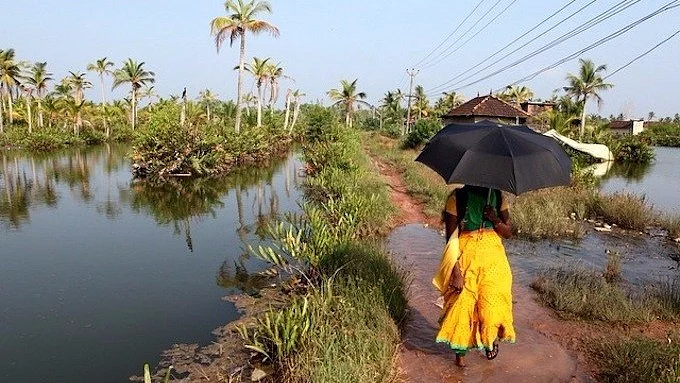A splash of green, a series of picture postcards flashing by the windows of southbound trains to the ancient port town of Kollam in Kerala, Munroe Thuruthu is a string of eight islands reclaimed from the backwaters. Of late, water seems to be demanding back a part of this land.
In these scenic islands, named after John Munroe – a popular administrator of the erstwhile British East India Company and the princely state of Travancore – local villagers are finding their backyards flooded, house walls damp and cracked with paint peeled off. Those who make a living out of coir making, fish farming and tourism are concerned that flooding could affect their livelihoods. Even riverine fishers, who often live on the backwater banks, could be facing erosion and subsidence of land.
Those who can afford to move away are doing so.
No one wants to live in a sinking island. We planned to come back here after retirement. But now, we don’t want to take any risk.Ponmani, 60, Retired Schoolteacher from Munroe Thuruthu
Growing Risks
Although risk perceptions are lower among many other residents, experts are beginning to study why these backwater islands, a five square mile area inhabited by 10,000 people 25 km north of Kollam, are getting wetter.
The backwaters, an intricate 900 km network of lagoons, lakes, canals and estuaries along the Arabian Sea – from which they are separated by low elevation barrier islands, sand bars and beaches – support local livelihoods and attract tourists to the state. Kerala, which calls itself ‘God’s Own Country’, attracted close to a million foreign tourists in 2015, fetching an equivalent of Rs 70 billion. The number of domestic tourists was over 10 times as much and tourism helped the state earn a total of Rs 267 billion, about 12% of its GDP.
But in a changing climate, the barrier beaches of Anchuthengu, Alappad, Arattupuzha, and Kadappuram could change shape as sea levels rise. This was noted by an earlier investigation by the National Centre for Earth Science Studies (NCESS) based at the state capital Thiruvananthapuram. Out of 389 islands in the backwaters, 230 face tidal influence, and they could also be vulnerable along with the backwater banks, NCESS reported.
Average global sea-level-rise as estimated by the Intergovernmental Panel on Climate Change (IPCC) is 3.2 mm per year. The National Institute of Oceanography, based in Goa, has found a matching trend in India. The problem is not so much the gradual rise, but the fact that it leads to higher tidal and storm surges. On top of that, deltas with loose sediment face the problem of soil subsidence. For instance, Diamond Harbour in the Gangetic Delta south of Kolkata, is sinking at the rate of over 5 mm a year.
Vanishing Protective Barriers
The islands were once known for mangroves, and there is even a local spot called Kandal Kinaru (mangrove well). But there is no trace of mangroves here anymore. Therefore, there is no way to buffer higher tides and storm surges. Degradation of wetlands could lead to delta and coastal subsidence as studies elsewhere show. Wetlands are areas where water covers the soil near the surface, and mangrove patches are good examples of that.
Former Member of Parliament and Kollam district secretary of the state’s ruling Communist Party of India (Marxist), KN Balagopal, addressed these problems in the Upper House of the assembly five years ago. He says many families have left the islands in recent years. “As long as the people stay here, further construction must be done with light building materials,” Balagopal told indiaclimatedialogue.net. In Kerala, modern houses are usually built with brick walls and concrete roofs.
Hari Narayanan, Member Secretary to the State Science and Technology Council, supports the case for stronger foundation and piling. “Residential buildings are sinking because none of the houses are built after proper concrete piling. There used to be coconut tree piling for old houses. Those houses do not sink.”
Meanwhile the islands that honour the colonial administrator remain an idyllic tourist location for home stays and canoe cruises, and a backdrop for Kerala’s brand of nostalgic literature and cinema.
(This piece, by MM Paniyil and Ajith Lawrence, was originally published in India Climate Dialogue and was edited for length. Read the full piece here.)
